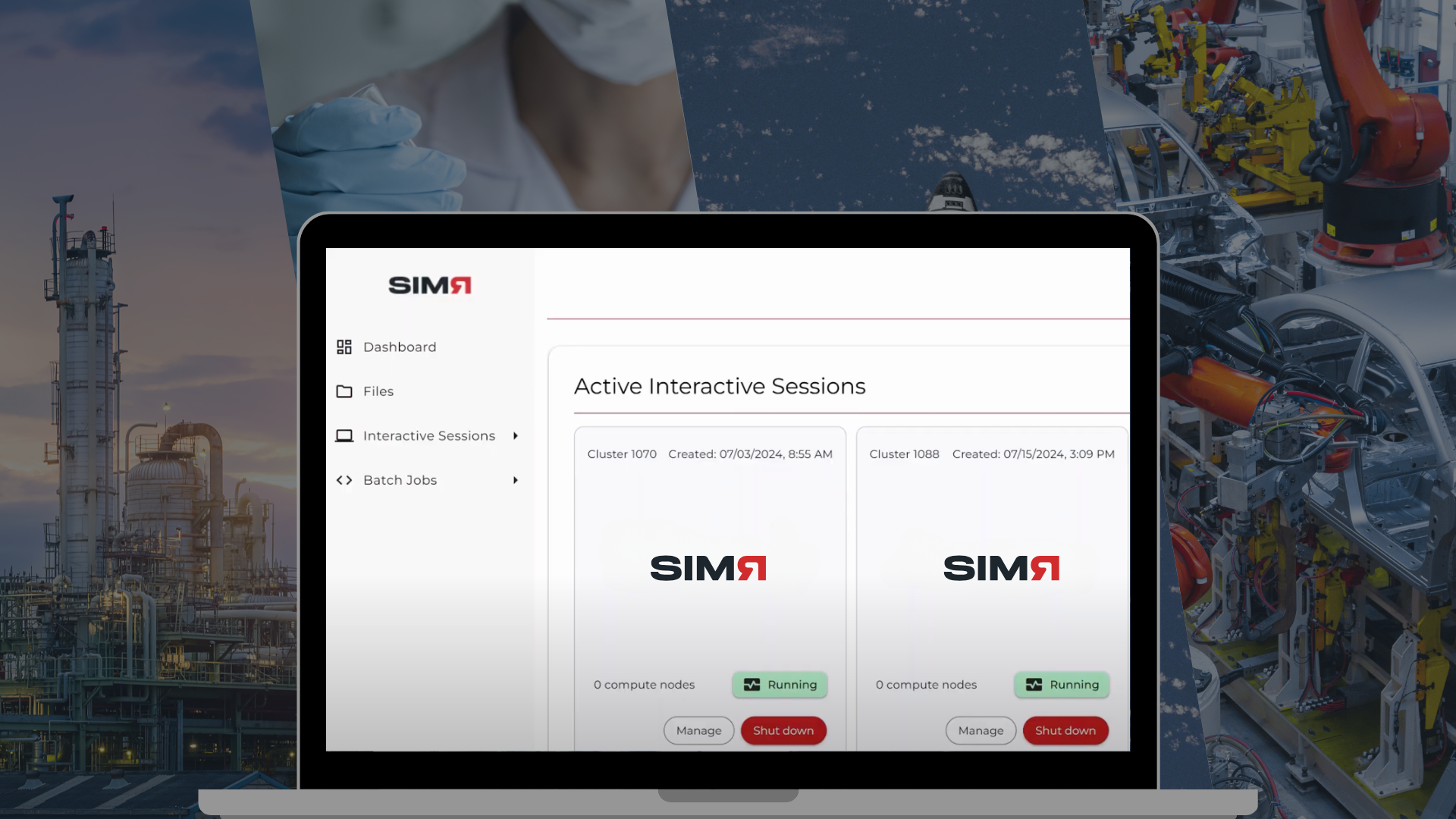Artificial Intelligence in Manufacturing - a Simr Compendium
Explore the Simr Compendiums, featuring over 160 case studies on projects showcasing a decade of innovation in cloud-based High-Performance Computing (HPC)
FAQ
Empower your creativity and efficiency with our pioneering cloud-powered Simr's platform.
Get in touch
Simr is a cloud-based Simulation Operations (SimOps) platform that streamlines and automates complex engineering simulation workflows. It minimizes the complexities of high-performance computing (HPC) environments, allowing engineers to focus on innovation and rapid product development. In essence, Simr provides a secure, scalable self-service HPC platform for running simulations in the cloud or on-premises, integrated with leading computer-aided engineering tools.
Simr simplifies high-performance computing complexity by automating the setup and management of HPC infrastructure. The platform handles provisioning, configuration, and maintenance of compute resources, which reduces the operational burden on IT teams. This automation means engineers don’t need to worry about cluster details – they can run simulations easily, making HPC-driven projects more accessible and productive.
The Simr platform supports a wide range of engineering and scientific simulations. This includes workloads like Computational Fluid Dynamics (CFD), Finite Element Analysis (FEA), multi-physics simulations, and system-level models. Simr is compatible with major CAE software packages such as Ansys, Abaqus, COMSOL, CST Studio, STAR-CCM+, MATLAB and many others, allowing users to run their preferred simulation tools on the platform.
Simr is cloud-agnostic and supports multiple deployment models. You can deploy Simr within your own public cloud accounts on AWS, Microsoft Azure, or Google Cloud, and it can also be installed on private on-premises infrastructure. This flexibility means Simr can be used in cloud-only, on-premises, or hybrid environments, letting companies leverage existing IT investments and comply with internal policies while using Simr.
Yes. Simr’s architecture leverages containerization and Kubernetes for orchestration of simulation workloads. The platform uses secure containers to encapsulate engineering applications and their dependencies, and it employs fully automated orchestration with Kubernetes to deploy and manage these containerized workloads at scale. This modern approach ensures that simulations run in a consistent environment and can be easily scaled or moved across different cloud or cluster environments.
Yes. Simr supports running GPU-accelerated workloads and MPI-based parallel simulations on HPC resources. The platform allows users to utilize GPU-equipped cloud instances for computationally intensive tasks (unlike some limited vendor cloud offerings that exclude GPUs). It can also orchestrate multi-node clusters for distributed MPI computations, enabling simulations to run on any number of nodes as needed for large-scale parallel jobs. This means Simr can handle both GPU-based computing and traditional CPU+MPI high-performance computing scenarios.
Simr is designed to scale resources on-demand to meet the needs of large or complex simulations. Engineers can easily expand or shrink the compute cluster size for their simulation runs, scaling the volume of simulations up or down as required. Behind the scenes, Simr automatically provisions and tears down cloud HPC nodes through its orchestration, so even very demanding simulations can run with virtually unlimited capacity while controlling costs and without manual infrastructure work.
Simr uses a straightforward subscription licensing model based on per-user (per seat) licenses. In practice, customers pay an annual or monthly fee for each user of the platform. There are no additional charges for HPC compute time or cloud usage imposed by Simr – users pay their cloud provider directly for the infrastructure, with Simr itself charging only the fixed per-user software fee. This no-markup approach encourages extensive simulation use by avoiding per-job or per-hour platform fees.
Yes. One of the advantages of Simr’s approach is that it runs in your own controlled environment, which means you can leverage your existing simulation software licenses (for tools like Ansys, COMSOL, Abaqus, etc.) on the platform. You retain full control over your CAE software licenses and workflows – Simr does not require you to purchase new licenses or switch to a different licensing scheme for your simulation tools. This integration ensures that your current license entitlements and license servers can be used seamlessly with Simr.
Simr places security at its core. The platform is deployed within your secure cloud environment or data center, meaning all simulation data remains under your organization’s control. It implements enterprise-grade security measures such as end-to-end encryption of data, identity-aware proxy (IAP) access control, and adheres to compliance standards like GDPR and HIPAA. By allowing customers to apply their own security policies and by providing a single-tenant isolated environment, Simr ensures sensitive engineering data is protected and meets regulatory requirements.
Yes. A comparison with the 20 major SimOps Best Practices shows that the Simr Engineering Simulation Platform complies with all SimOps Best Practices. And what is SimOps? SimOps, Simulation Operation Automation, is committed to advancing the field of simulation operations by empowering the global engineering and HPC operations community through education, collaboration, and innovation. SimOps's mission is to enrich the entire engineering simulation ecosystem by offering training programs, fostering knowledge sharing, and promoting best practices that improve efficiency, scalability, the impact of simulation processes, and the productivity of simulation engineers—ultimately leading to higher-quality products. By uniting stakeholders across the simulation landscape, SimOps strives to drive progress, spark innovation, and ensure that simulation operations play a central role in the future of engineering and product development. Learn more at www.simops.com.











Featured case studies

Explore the Simr Compendiums, featuring over 160 case studies on projects showcasing a decade of innovation in cloud-based High-Performance Computing (HPC)
VIEW POST

In 2021, Rimac and UberCloud forged a partnership, with a need for optimized innovation at its core. Rimac Technology engineers were running more and more simulations with an aging, on-premises high performance computing (HPC) cluster. While compute power continued to fall short, the demand for resources continued to grow exponentially.
VIEW POST

Explore the benefits of ANSYS in the Cloud by withaeroelastic behavior and flutter instability of aircraft wings in subsonic flight using simulations.
VIEW POST

This case study evaluates antenna performance and SAR using ANSYS HFSS, achieving faster simulations.
VIEW POST

Discover the benefits of ANSYS in the Cloud for evaluating wind turbine performance using CFD, enabling fast and efficient simulation trials with minimal setup.
VIEW POST

In this project, we calculated the KRISO containership's barehull resistance in the cloud. KCS is a standard benchmark in marine CFD with published data.
VIEW POST
Featured blog posts

HPC
Unlock the potential of HPC with Simr's portable workflows. Learn about HPC architecture, challenges, and how to simplify complex simulations in the cloud.
VIEW POST

SimOps simplifies engineering simulations with automation, user-friendly tools, and training, bridging the HPC skills gap for innovation and growth.
VIEW POST
.png)
We calculate the total cost of an engineering simulation workplace in the cloud, and contrast this with the potential benefits of such an investment.
VIEW POST

Imagine every aspect of your IT infrastructure is seamlessly integrated. With Simr, that begins with our end-to-end high-performance computing platform.
VIEW POST
%20Large.jpeg)
Discover how the Living Heart project leverages cloud computing, featuring collaborations with Stanford, NIMHANS, ADMEDES, ENMODES, and 3DT Holdings
VIEW POST
.png)
At Simr, our mission is clear: to help companies thrive in the simulation economy through our advanced Simulation Operations Automation (SimOps) platform. Founded by engineers for engineers.
VIEW POST
Solutions
Product